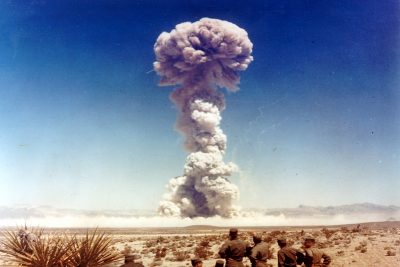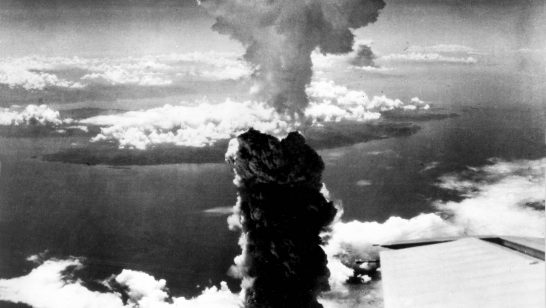
In a speech to the Friedrich Ebert Stiftung foundation, Lord Des Browne stresses NATO’s need to seek a new role for Nuclear weapons sensitive to the needs of all members of the alliance. Recognising the changed international atmosphere surrounding Nuclear Security, Lord Browne argues that NATO has both an opportunity and an obligation to take concrete steps towards reducing the role of Nuclear Weapons in its deterrent posture.
Current NATO Nuclear Policy
I want to start my comments today by reminding us of four aspects of current NATO nuclear policy.
First, and as captured in the language of the 1999 Strategic Concept, a formulation that in turn, by the way, uses the same words as those used in the 1991 Concept, ‘the fundamental purpose of the nuclear forces of the Allies is political: to preserve peace and prevent coercion and any kind of war.’
Second, and according to the same document ‘the nuclear forces based in Europe and committed to NATO provide an essential political and military link between the European and the North American members of the Alliance.’
Third, NATO currently argues that nuclear forces fulfil their essential role by ensuring uncertainty in the mind of any aggressor about the nature of the Allies’ response to military aggression’ (note, not just nuclear aggression, but military aggression more broadly defined).
Fourth, and to deliver both the deterrent effect to any potential adversary and the transatlantic cohesion effect described, the current policy says that NATO nuclear forces need to be perceived by all as ‘both a credible and effective element’ of the Allies’ strategy in preventing war.
My message to you today is that while there is no case for NATO giving up all its nuclear forces unilaterally there is also no real case for continuing with the status quo.
I say this for three principle reasons.
The Changed Context
First, the diplomatic context today is quite different to the context within which current NATO policy was formed.
President Obama’s speech in Prague in April 2009 in which he committed to seek the peace and security of a world without nuclear weapons has put us, I believe, into a new era of policymaking and has opened up new possibilities which NATO has to pursue.
The follow up to the President’s speech with UN Security Council Resolution 1887 in September 2009 and the Washington Nuclear Security Summit in April 2010 demonstrated broad international support for the objectives the President set out.
More recently, and after a gap of almost a decade, the United States and Russia have resumed strategic arms control negotiations, signing the New START Treaty in Prague in April. If ratification can be achieved, this will add to the momentum and lead to follow on talks with the potential to achieve much deeper cuts.
In May of this year too, a successful outcome was also achieved at the NPT Review Conference in New York, though one should not underestimate what a close run thing it was and how much international pressure among non-nuclear weapons states there now is to see serious disarmament among the nuclear weapon states parties to the NPT.
In my view, there is an opportunity and obligation for the alliance to build further on these recent achievements. The question for NATO as it revises its Strategic Concept ahead of Lisbon is what can it do to add to the disarmament momentum without either undermining alliance cohesion or taking unnecessary risks with alliance security? Just sticking with the status quo NATO nuclear position will look insensitive at best and may make the alliance appear oblivious and irrelevant to the changing world taking shape beyond its own borders.
Second, and at a more practical level, Under President Obama’s leadership the United States has conducted a Nuclear Posture Review, a process which resulted in a commitment by the US ‘not to use or threaten to use nuclear weapons against non-nuclear weapons states that are party to the NPT and in compliance with their nuclear non-proliferation obligations.’
There appears to be some discrepancy between the new US position and the position agreed by NATO in 1999, to use nuclear forces to ‘ensure uncertainty in the mind of any aggressor about the nature of the Allies’ response to military aggression.’ This discrepancy extends to the different declaratory policies of the UK and France. It needs to be addressed given the reality that it is US nuclear forces that provide the essential backbone of NATO’s nuclear deterrent capability. Here the question for NATO as a whole is not only what can it do to reduce the declared roles of nuclear weapons in alliance strategy, but what must it now do to make sure its own strategy is internally coherent.
Third, and most importantly in my view, the internal political dynamics of NATO, as they relate to nuclear policy, have changed since 1999. The foreign ministers of several countries have called for a fuller debate on the future of US sub-strategic nuclear weapons stationed in Europe. In some member countries of the alliance political momentum has swung behind a desire to see these weapons removed, and there are increasing question marks over the political ability of some European governments to replace the ageing dual capable aircraft upon which these weapons rely. The military utility of the same weapons is increasingly being questioned, and so too, as a result, is their deterrence value and credibility in the eyes of any potential aggressor.
On the other hand, there are some in the alliance who are worried about any decision to remove these subs-strategic weapons because they believe it may signal a weakening of the transatlantic link and a weakening of US resolve to defend allies in Europe should they come under attack.
I want to dwell on this point because, in my view, there are serious issues at stake here and they go well beyond alliance nuclear policy. Indeed, the debate on the future of US sub-strategic weapons stationed in Europe is becoming a proxy for a much more fundamental debate about the confidence of NATO allies in each other. There is also, I believe a mis-understanding taking place about what the real drivers of attitudes in the different parts of the alliance actually are.
There are some in Europe, for example, who think the US administration’s interest in nuclear disarmament merely reflects the idealist elements of President Obama’s make-up and that the current emphasis on disarmament will pass. This could not be further from the truth. What is going on in the US is a change in the hierarchy of perceived threats to US national security, with new nuclear threats moving to the top of the list. There are individual countries of concern, like Iran, North Korea, and Pakistan; there are concerns over regional proliferation dynamics in the Middle East and South and east Asia, concerns over terrorists acquiring a nuclear capability; and a realisation that as the global nuclear industry expands to meet the challenge of climate change so will the availability of potentially lethal nuclear material. Without further action, the perception is of a real danger that the US, and the world, will be overwhelmed by proliferation risks and incidents of nuclear weapons use, with all their catastrophic consequences.
The strategic lesson that many in the US are drawing from this is profound. Nuclear deterrence is coming to be seen as a far less persuasive strategic response to a world of potential regional nuclear arms races and nuclear terrorism than it was to the Cold War. Although the US is not dictating what NATO nuclear policy ought to be to the rest of the alliance, it is beginning to re-think deterrence and what it requires as a whole, with a view to downgrading the role and place of nuclear weapons within it. It is doing so because it no longer believes that status quo thinking on nuclear deterrence represents the safe option for the long term. This has serious implications for how the US will come to understand deterrence, burden-sharing and the requirements of a strong transatlantic link within the context of NATO as a whole and therefore serious implications for the way European allies need to think about these issues as well.
On the other hand, there are those in the US and western Europe who think some European allies are reluctant to let go of the US sub-strategic weapons only because they are trapped in Cold War thinking. Again, this could not be further from the truth.
I have come here from meetings in Turkey where I have been discussing, with colleagues, the issue of NATO nuclear policy in the context of the threats facing that country. My over-riding impression is that the sub-strategic weapons stationed there have an importance to Turkey, not because of the weapons themselves or their military utility but because the relationship between Turkey, the US and its NATO allies is under strain for other reasons. Turkey perceives threats to its national security which is does not think its allies understand. Its concerns are now dominated by events in the Middle East not Europe. It does not feel as secure as some countries in the West European part of the alliance. Turkey’s relationship with and confidence in the US was deeply damaged by the experience of the Bush administration and by what it perceives as the failure of the US to help Turkey in its struggle with the PKK. Turkey is not wedded to US sub-sub-strategic weapons but in the absence of its other concerns being addressed, they have become of symbolic importance. If its wider concerns can be addressed, progress on NATO nuclear posture might be possible.
I will not dwell on them here, but there are similar dynamics at work in central and eastern Europe.
The point of all this, in my view, is that the alliance is not having the honest conversations it needs to have to make progress on the challenges it needs to address today.
Next Steps
For me, the implications of all this for NATO are clear. The Allies cannot and should not avoid a re-examination of the 1999 nuclear policy formulation and what it means in practice but in addressing it, must engage in a serious conversation about more fundamental issues.
The core ideas of deterrence, alliance solidarity, burden sharing, and the transatlantic link remain central to our security but the question before the Alliance is how best to implement them in the changed circumstances we face today. In particular, how best to implement them in ways which simultaneously sustain alliance cohesion by providing reassurance to all members of the alliance, but also increase NATO’s contribution to global momentum on multilateral nuclear disarmament and non proliferation, and enhance the prospects of further fruitful arms control dialogue with Russia.
For me, and for over 30 other European colleagues who signed the recent leadership statement on NATO nuclear policy, this points to the need for a full, inclusive and transparent review of NATO force posture that addresses the following questions:
a. What can NATO do to help establish safe conditions for the adoption of deterring nuclear attack as the sole purpose for its nuclear weapons, consistent with the direction of travel set out in the US NPR and with the ambition to reduce the number and roles of nuclear weapons in the NATO arsenal?
b. Are NATO’s current nuclear arrangements the only available and credible option for providing European allies with reassurance? What alternative options are available that could provide this reassurance while also allowing NATO to do more to support international moves toward multilateral nuclear disarmament? What might the risks and benefits of each of these alternatives be?
c. What alternatives to current nuclear burden-sharing arrangements might be available, if any, that could both maintain the political cohesion of the alliance and maintain the principle that nuclear risks and burdens are shared across the alliance while also allowing more courageous steps on nuclear disarmament to be taken?
d) How can we best engage with Russia on this agenda?
These are important questions. They go to the heart of NATO’s approach to delivering its own security, its longer-term political cohesion in changing conditions, and the stability of its relationship with Russia. The challenge for NATO is now to simultaneously maintain its own cohesion while moving to strengthen the global non-proliferation regime and further reduce urgent nuclear dangers. The alliance has a responsibility to show more leadership on the nuclear challenges of the 21st century. It must do so by pursuing an honest conversation within its own membership.
The opinions articulated above represent the views of the author(s), and do not necessarily reflect the position of the European Leadership Network or any of its members. The ELN’s aim is to encourage debates that will help develop Europe’s capacity to address the pressing foreign, defence, and security challenges of our time.



